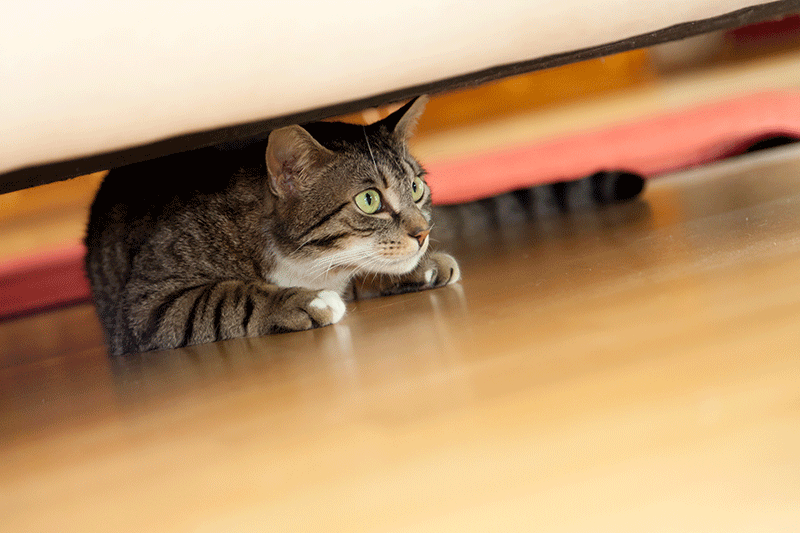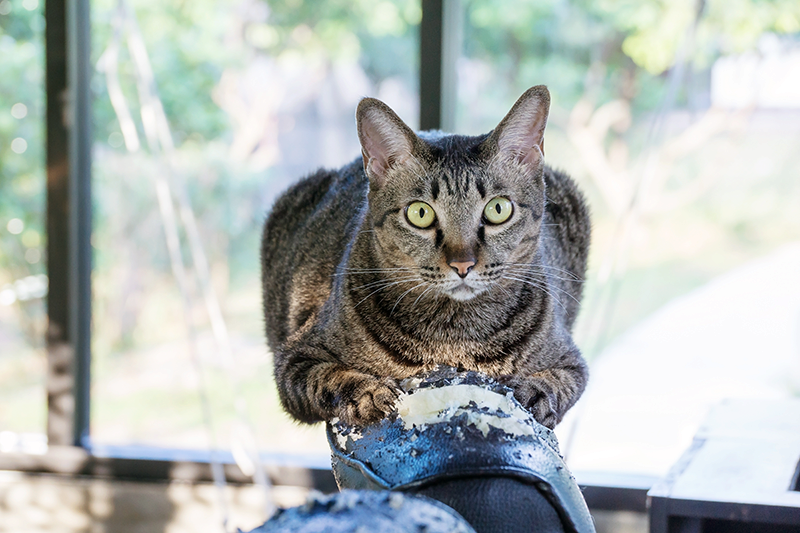How to Minimize Your Cat's Stress When Moving
Cats are territorial animals, and changes in their home can cause stress. Whether you're moving with your cat across the country or moving nearby with lots of renovations, cats really need to have some semblance of control over their surroundings. When that changes, they get stressed out.
Moving homes can be challenging for cats. They become quite attached to their environment. Each room and each piece of furniture is marked with their scent as a way to establish their territory. Just moving furniture around, redecorating, or adding new pieces can stress some cats because you're changing the territory she knows so well. This is even more stressful when you're changing environments entirely and can result in scratching, urine spraying, and other stress-related behaviors.
Prepare for the Move
No matter what type of move—whether across the country or just one rented space to another—there are basic steps you can take to make the whole thing less stressful for your cat.1
Try to maintain your cat's routine while you're packing and getting ready for the move. This includes keeping the same bedtime, playtime, and mealtime. Set out the moving boxes and the cat carrier weeks ahead, so they become a normal part of your cat's life.
Ensure your cat is microchipped and registered online in case the worst happens, and your kitty gets lost at some point.
Make Moving Day Less Stressful
On the day of the move, place your cat into an empty room and close the door. Leave food, bedding, a litter tray, and a piece of furniture under which he can hide. Place the cat carrier in the room with its door open. Make sure your movers know the door to the room must remain closed to prevent your pet from running away. (Sometimes taping a sign to the door helps everyone remember.) This not only keeps your pet safe, but it keeps him away from big boxes and strangers that can leave him feeling uneasy.
Take the same type of approach when you arrive at your new home. If you can, try to unload one room first. You can place your cat here to rest and recover from the journey while you sort out the rest of the house. At the very least, you can put your cat in a bathroom with the door shut. Just make sure you have a litter box, water, food, and a comfy cat bed to help your cat feel less stressed by all the noise outside the closed door.
Get Your New Home Ready
If you have access to the new property before you move, it is helpful to plug in a Comfort Zone Calming Diffuser to make your cat feel more comfortable when she arrives. You want to set one up before you renovate or change the furniture around, even if you're staying in the same house. The diffuser lasts for four weeks and helps your cat adjust to a changing environment.
The diffuser releases a drug-free, odorless vapor that mimics the pheromones a cat releases to indicate an area is safe and secure. So by setting one up ahead of time, you're signaling in your cat's language that she can relax. This can help cut down on stress behaviors like spraying or destructive scratching.
Putting some scents that are familiar to your cat in your new home ahead of time can help too. Favorite toys or a familiar-scented towel can cut down on stress.
Many triggers can stress out your cat, such as moving, hearing loud noises, or having a new pet or new furniture in the house. Try to help your cat experience as few of these at one time as possible.
Moving with Your Cat Long Distance or Across the Country
Of course, some special circumstances require extra planning. If you're moving a long distance or even across the country (or the world), you need to take extra precautions.
If you have to travel on a plane with your cat, you need to decide on flying together in the cabin versus checking your cat into the plane's cargo area. If at all possible, travel together in the cabin, but be sure to check with your airline for their specific requirements. Make sure your cat's weight and carrier size meet the airline's specifications. The K&H Lookout Pet Carrier is potentially a good option because the small size meets some requirements. You will need other travel supplies, vaccination records, and a harness in case you have to take your cat out of the carrier for the X-ray screening.
If you're traveling with your cat in a car, it's a little easier but still requires some planning ahead. Find a good carrier, like the Travel Safety Carrier that secures to the seat and keeps your cat from moving while you drive. Take short trips at first to help your kitty get used to the drive. Pack travel supplies like a small litter box and portable water and food dishes, along with a harness.
Tell your cat in her language that the trip is safe with the Comfort Zone Calming Collar. It emits those calming pheromones and fits around your cat's neck and easily releases if she becomes entangled. Double down with the calming assistance and spray the Comfort Zone Spray & Scratch Control Spray in her carrier and on her blanket.
Moving with Outdoor Cats
If your cats are mostly outdoor kitties, you need to keep a few additional tips in mind for the big move. Make sure you have up-to-date vaccination tags and have registered their microchips online. Help your outdoor cats get used to a car-safe carrier by leaving it outside for a few days with your cat's favorite treats, blankets, or toys inside.
When you get to your new destination, keep your cat indoors for a few days or up to several weeks. She'll be very nervous by all the new sights and sounds, and you don't want her getting scared and running away.
Keep a comfy bed like the Thermo Outdoor Kitty House in your garage or other indoor room with your cat. You'll ultimately move your kitty and the house outside at the same time. Stay outside with your cat at first and bring her back in every night.2 Helping your outdoor kitty adjust to a move can be a long process, but it's worth the time to help her stay safe.
Moving with Multiple Cats
When you're moving with multiple cats, you need to make sure they don't get so stressed that they take it out on each other. That means quickly setting up plenty of places that they can "claim" for themselves, such as window perches, cat trees, cat condos, and cat beds. Plug in a Comfort Zone Multi-Cat Calming Diffuser to help the cats feel secure. The calming diffuser releases a drug-free, odorless vapor that mimics cats' natural calming pheromones. This helps your cats know the area is safe. Also, stick to their routine as much as possible, including mealtimes and playtimes.
Be Patient
Remember that adjustments can take time, so be patient with your kitty. It's best to expand your cat's territory slowly. Let him get used to one room at a time and slowly expand to include the yard. When you first allow your cat outside, choose a weekend when you are home, and let him out just before mealtime. You might even want to just take him outside on a harness or in an escape-free tent once you're at that point, keeping him extra safe.
Being aware of how all these changes can affect your cat can help you make the transition as stress-free as possible. Before long, your kitty will be loving the new scenery and will return to being her usual purring, happy self.
1. Fetch by WebMD. "Moving to a New Home with a Cat." Pets.WebMD.com, https://pets.webmd.com/cats/guide/moving-new-home-cat#1.
2. Morris, Joan. "Tips for Moving Your Outdoor Cat to a New Home." Mercury News, 11 August 2016, https://www.mercurynews.com/2016/07/29/tips-for-moving-your-outdoor-cat-to-new-home/.




